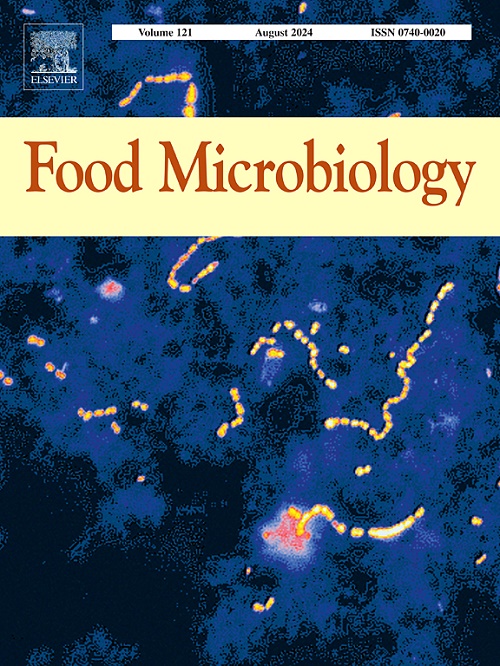Inoculation with autochthonous yeast strains in Harbin dry sausages with partial substitution of NaCl by KCl: Bacterial community structure and flavour profiles
IF 4.5
1区 农林科学
Q1 BIOTECHNOLOGY & APPLIED MICROBIOLOGY
引用次数: 0
Abstract
The effects of two autochthonous yeast strains (Pichia kudriavzevii and Debaryomyces hansenii) on the physicochemical characteristics, bacterial community structure, and flavour profile of the dry sausages with 40% substitution of NaCl by KCl were evaluated in this study. The results revealed that the inoculation of yeast strains increased the pH and yeast counts of low-sodium sausages. Higher contents of total esters, aldehydes, and ketones were detected in the inoculated sausages (P < 0.05). Based on the results of high-throughput sequencing, the inoculation of P. kudriavzevii decreased the abundance of Lactobacillus, Weissella, and Leuconostoc. However, the inoculation of D. hansenii increased the abundance of Lactobacillus, Weissella and Staphylococcus, which may help to inhibit the growth of pathogenic microorganisms in sausages. Electronic tongue analysis as well as sensory evaluation revealed that D. hansenii reduced bitter, astringent, and metallic tastes (P < 0.05). Overall, D. hansenii can be used as the prospective stater culture to compensate the flavour defects and improve the safety of the dry sausage with NaCl substitutes.
用KCl部分替代NaCl接种哈尔滨干香肠:细菌群落结构和风味特征
以KCl代替40% NaCl的干香肠为研究对象,研究了两株本土酵母(Pichia kudriavzevii和Debaryomyces hansenii)对干香肠理化特性、细菌群落结构和风味特征的影响。结果表明,接种酵母菌株可提高低钠香肠的pH值和酵母计数。在接种的香肠中检测到较高的总酯、醛和酮含量(P <;0.05)。高通量测序结果显示,接种P. kudriavzevii可降低乳酸菌、魏塞尔菌和白菌的丰度。然而,接种猪肠杆菌增加了乳酸菌、魏氏菌和葡萄球菌的丰度,这可能有助于抑制香肠中病原微生物的生长。电子舌头分析和感官评价显示,汉氏菌减少了苦味、涩味和金属味(P <;0.05)。综上所述,汉塞弧菌可以作为一种有前景的酵母培养物,弥补其风味缺陷,提高盐代用品干肠的安全性。
本文章由计算机程序翻译,如有差异,请以英文原文为准。
求助全文
约1分钟内获得全文
求助全文
来源期刊

Food microbiology
工程技术-生物工程与应用微生物
CiteScore
11.30
自引率
3.80%
发文量
179
审稿时长
44 days
期刊介绍:
Food Microbiology publishes original research articles, short communications, review papers, letters, news items and book reviews dealing with all aspects of the microbiology of foods. The editors aim to publish manuscripts of the highest quality which are both relevant and applicable to the broad field covered by the journal. Studies must be novel, have a clear connection to food microbiology, and be of general interest to the international community of food microbiologists. The editors make every effort to ensure rapid and fair reviews, resulting in timely publication of accepted manuscripts.
 求助内容:
求助内容: 应助结果提醒方式:
应助结果提醒方式:


